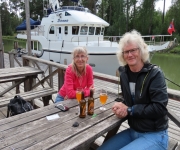Posts In The “Denmark” Category

For us, 2019 was the “Year of the Canal”. We spent much of the year cruising the Baltic Sea, and passed through an incredible 98 locks while transiting several major and minor canal systems, including the Kiel Canal across Germany, the Saimaa Canal through Russia to Finland’s Great Lake Saimaa system, and the Gota and…

After an excellent week in Copenhagen, we reluctantly departed to continue south towards Amsterdam. Over two nights, with an overnight stop in the Smalandsfarvandet, we ran 153nm to just inside the Kiel Canal at Lake Flemhude. Shortly after departing Denmark and entering Germany, our US registration again attracted an official inspection, this time from the…

Copenhagen’s Orestad neighbourhood, southeast of the city center, is known for its spectacular modern architecture, so much so that companies run architectural tours of the area. On our final day in Copenhagen, we made our own architectural tour of Orestad by bicycle. We were really impressed with the modern and innovative architecture, including several by…

We were lucky to be in Copenhagen for the city’s annual culture night, where over 250 museums, churches, theatres, libraries, city buildings and businesses host a public open-house. After going through the list of participants, we selected a tour of the world-wide headquarters of Danish shipping company A.P. Moller – Maersk and the Copenhagen Opera…

Kastellet (the “Citadel”), just north of the city center, was commissioned by Frederick III in 1662 to defend the port of Copenhagen. The pentagon-shaped structure is today one of Northern Europe’s best-preserved forts. On our fifth day in Copenhagen, we walked north of Nyhavn to visit Kastellet. On the way, we toured Amalienborg Slot and…

Danish architects and designers have long been internationally known for their innovative and striking creations. The iconic Sydney Opera House, for example, was designed by Danish architect Jorn Utzon. Copenhagen, of course, is full of spectacular examples of their work and a great way to see many of them is from the water. On our…

Amager Bakke is a cutting-edge waste-to-energy plant with a year-round, no-snow ski hill and walking and running paths built onto the roof. The slope-roofed structure, completed recently this year, dominates the skyline northeast of Copenhagen and was a prominent landmark when we approached the city from the north. The innovative design is the product of…

Christiansborg Palace, now the seat of the Danish Parliament, is the fifth castle built at the same location in Copenhagen. The first, built in 1167 the city’s founder Bishop Absalon, was destroyed in the 1300s. A second castle, completed later in the 14th century, was demolished to make way for Christian IV’s grandiose baroque palace…

Copenhagen has been the capitol of Denmark since the 15th century and is the largest city in the country, with more than two million people living in the metropilitan area. It also is the governmental, economic and cultural center of the nation, and has a wide variety of museums, theaters and galleries. Despite its size,…

Kronborg Castle at Helsingor, Denmark evolved from a 15th-century medieval fortress to a magnificent Renaissance castle. The Danish King Frederick II constructed the castle in the mid-1500s using funds gathered from the tolls that ships had to pay Denmark on passing through the Oresund. It was these tolls that prompted the Swedish to build the…

Denmark’s National Maritime Museum is built on the site of an old dry-dock in Helsingor. One of the stipulations of the design competition was that the museum be contained entirely in the dry-dock and not extend above street level. Where most designs proposed building the museum inside the dry-dock with a roof on top, the…

Frederiksborg Castle, a Dutch-Renaissance palace built in the early 1600s as a residence for Christian IV, is one of the most impressive buildings in Denmark with over 80 rooms full of paintings, tapestry, furniture and spectacular gilded decor. After a fire in 1859 destroyed much of the castle, Carlsberg brewery founder J. C. Jacobsen was…

The tiny island of Anholt is 7 miles (11 km) long and about 4 miles (6.4 km) wide and is 80% desert, making up the largest desert in Northern Europe. Just to the west is the 400-megawatt Anholt Offshore Wind Farm, the largest in Denmark and one of the largest wind farms in the world….

Laeso, a Danish island in the Kattegat, is famous for its seaweed houses that are found nowhere else in the world. Seaweed is an excellent insulator and the islanders began using it for roofing since Laeso became deforested by the 1600s. The seaweed roofs can last up to 400 years, but many are in a…

Denmark’s peninsula of Jutland is bordered on one side by the Skagerakk in the North Sea and on the other by the Kattegat in the Baltic Sea. At Grenen, a long spit off the northern tip of Jutland, you can walk out the end and stand with one foot in each body of water. Excellent…

Skagen, at the northern tip of Denmark, is the largest fishing port in the country and lands one quarter of the total Danish catch by value. It is the home port for the Ceton, the pelagic trawler that we toured in Donso, and one of the reasons we wanted to visit was to see some…

The Danish island of Bornholm has been fought over for centuries by Denmark, Germany, and Sweden. The 227sq mi (588 sq km) island is the 8th largest in the Baltic Sea, lying 80nm east from the nearest Danish land, 45 miles from Germany and only 25 miles from Sweden. Prominent on the northwest coast of…

We reached Denmark the day after transiting the Kiel Canal, and anchored for the night at the west end of Smalandsfarvandet. The next day we passed through eastbound to Klintholm, where we rode our bikes out to view the famous Mont Klint chalk cliffs and enjoyed touring the area. Being early in the season, we…